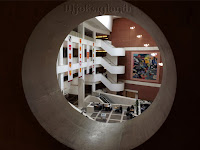 I'd been to the British Library before, when I had a few hours before my train to Wales; if all you can do is go in and admire the Treasures, it's still worth a stop. But, of course, being able to take a tour behind the scenes is much more interesting.
I'd been to the British Library before, when I had a few hours before my train to Wales; if all you can do is go in and admire the Treasures, it's still worth a stop. But, of course, being able to take a tour behind the scenes is much more interesting.For starters, the building is rather large, and it's actually even bigger than it looks. That's because there are four storeys of stacks belowground. They don't extend the whole length of the building, because, with the Library's proximity to three major train stations, there's a lot going on underground in that area of London. Still, there are a whole lot of books that visitors don't see. (Alas, we didn't get to go down there. I imagine it's fairly spare, though well-organized.) On the first floor, to the right, there's a scale model of the building that includes the basement levels.
 Before designing buildings, architect Colin St John Wilson served in the Navy. This nautical background is reflected in the building's profile, which resembles a large ocean-going vessel, as well as in other touches like windows and openings reminiscent of portholes. As you can tell, the building isn't very old, and the British Library as an institution isn't, either. Until the early 1970s the contents of the Library belonged to the British Museum; the British Library Act, passed in 1972, created the new national library. The building, which cost some exorbitant amount of money to construct, was formally opened by the Queen in 1998.
Before designing buildings, architect Colin St John Wilson served in the Navy. This nautical background is reflected in the building's profile, which resembles a large ocean-going vessel, as well as in other touches like windows and openings reminiscent of portholes. As you can tell, the building isn't very old, and the British Library as an institution isn't, either. Until the early 1970s the contents of the Library belonged to the British Museum; the British Library Act, passed in 1972, created the new national library. The building, which cost some exorbitant amount of money to construct, was formally opened by the Queen in 1998.A dimly-lit rectangle rising through the centre of the building is the King's Library. These books were originally in King George III's collection. Since most of the stacks are underground, the volumes in the King's Library may be the only shelved books you can actually see. This is also an interesting approach to rare books: they are often hidden away in rare book rooms, where few people might venture to see them, but here they are unmissable. Of course, they're still secure, inaccessible to patrons, and in a climate-controlled environment, but everyone knows they're there.
This summer the Library has an exhibition on Magna Carta in honour of its 800th anniversary. Photography was not allowed inside so I have no pictures of it; several copies, in whole and in part, in perfect condition and greatly damaged, from 1215 through 1297, were on display, along with other documents like the Charter of the Forest and artefacts from shoes to big swords. There was a clip of a performance of a play about Magna Carta from the turn of the century, and part of a Horrible Histories episode that discussed the document. Though my interest in the exhibition waned as I wandered further from the Middle Ages and closer to the present day, it was still a great display. One of the things I found most educational was the seal press. Authorities, including monarchs and popes, attached wax seals to documents rather than or sometimes in addition to signing them. I knew this, and I'd seen plenty of seals before, but I never really thought about how the seals were affixed. Apparently it takes a large wooden machine with a screw-press.
Then I spent a bunch of money on Magna Carta gifts and souvenirs. Even so, I could not justify spending £3.50 for the ginger fudge, no matter how much I wanted to try it.
An exhibit related to Magna Carta but not included in the larger display was Cornelia Parker's 'Magna Carta (An Embroidery)'. The piece is an embroidered representation of the Wikipedia article on Magna Carta as it appeared in June 2014. Parker herself didn't complete all of the stitching; a number of people worked on it, from Wikipedia founder Jimmy Wales to musician Jarvis Cocker to UK politicians, with most of the text stitched by prisoners. The Library's website says that the project 'responds to Magna Carta in the digital era'; though I'm not sure what that response is, I thought it was an unusual and kind of cool piece. It's also really weird to look at the Wikipedia page for the embroidery, since it's an article about a piece of art based on an article.
And lest you think the British Library is just a quiet, tweedy ivory tower, here's evidence to the contrary.



No comments:
Post a Comment